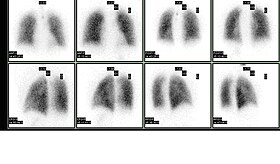Ventilation/perfusion scan
| Ventilation/perfusion scan | |
|---|---|
 Normal pulmonary ventilation and perfusion (V/Q) scan. The nuclear medicine V/Q scan is useful in the evaluation of pulmonary embolism. | |
| OPS-301 code | 3-703.2 |
A ventilation/perfusion lung scan, also called a V/Q lung scan, or ventilation/perfusion scintigraphy, is a type of
Uses
This test is most commonly done in order to check for the presence of a
A V/Q lung scan may be performed in the case of serious lung disorders such as
Significance of results

| Result | Interpretation | Significance |
|---|---|---|
| Normal | No perfusion deficit | Excludes pulmonary thromboembolism |
| Low probability | Perfusion deficit with matched ventilation deficit | < 20% probability of PE |
| Intermediate probability | Perfusion deficit that corresponds to parenchymal abnormality on chest x-ray | 20% - 80% probability of PE |
| High probability | Multiple segmental perfusion deficits with normal ventilation | > 80% probability of PE |
Decreased uptake of the inhaled radioisotope may indicate an impaired ability to breathe, airway obstruction, or possible pneumonia.
Decreased circulation of the injected MAA indicates a problem with blood flow into or within the lungs. A localized area of decreased uptake, usually in a wedge shaped (or pie shaped) configuration with normal ventilation images (mismatched defect) suggests a pulmonary embolus or blood clot in the lungs, which leads to reduced perfusion beyond the obstruction.
Risks
Although this test uses radioactive materials, the total amount of radiation exposure is low. Typical
Procedure
The ventilation and perfusion phases of a V/Q lung scan are performed together and may include a
In the ventilation phase of the test, a gaseous radionuclides such as
It is also possible to perform the scan with positron emission tomography (PET) rather than conventional gamma camera scintigraphy.[13] This has been performed with Gallium-68 labelled carbon nanoparticles (Galligas) using a conventional Technegas machine for ventilation images, and with Gallium-68 labelled MAA (Ga68-MAA) for perfusion images. PET has multiple potential advantages including superior resolution, speed and quantification.[14][15]
See also
References
- ^ "Pulmonary ventilation/perfusion scan". University of Maryland Medical Center. Retrieved 3 January 2018.
- S2CID 56486118. Retrieved 4 July 2021.
- PMID 25173341.
- ^ "Managing suspected pulmonary embolism". NICE. National Institute for Health and Care Excellence. January 2015.
- ISBN 978-1-4051-8460-1. Retrieved 14 November 2010.
- ISBN 978-1437735536.
- PMID 22282651.
- ^ PMID 19562336.
- PMID 18165667.
- ISBN 9781841847528.
- PMID 23218595.
- PMID 28461589.
- PMID 21908388.
- PMID 27553468.
- PMID 24396515.
